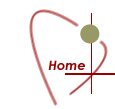Doppler
echocardiography (see figures 109, 110, 111, 112, 113) depends on the
detection of changes of frequency between intracardiac sound waves and
their reflections. The initial sound wave's frequency is the same as
that of its reflection only if the target is stationary. If the target
is moving toward or away from the source, then the reflected wave or
echo will have either a higher or lower frequency respectively. This
frequency shift (or Doppler effect) allows calculation of the velocity
of detected moving objects. In echocardiography, a column of blood can
be detected with the Doppler technique. The column is graphically shown
to be orange in color if it is moving toward the probe or blue if moving
away from the probe. This technique detects aberrant blood flow through
the damaged heart valves. For example, regurgitation of blood can be
detected in a damaged aortic or other cardiac valve during the filling
phase of the ventricles or atria. Abnormal flow can also be detected
in a site of an abnormal shunt of blood from our heart chamber to the
other (like an atrial septal defect or a ventricular septal defect (
see fig 20, 21), also see definitions of atrial
septal defect and ventricular septal defect).


